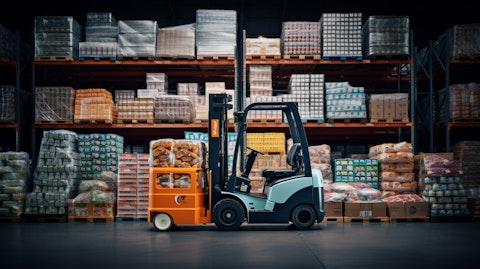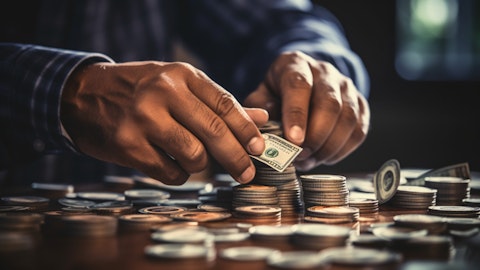Icahn Enterprises L.P. (NASDAQ:IEP) Q2 2025 Earnings Call Transcript August 4, 2025
Icahn Enterprises L.P. misses on earnings expectations. Reported EPS is $-0.3 EPS, expectations were $0.14.
Operator: Good morning, and welcome to the Icahn Enterprises L.P. Second Quarter 2025 Earnings Call with Andrew Teno, President and CEO and and Ted Papapostolou, Chief Financial Officer; and Robert Flint, Chief Accounting Officer. I would now like to hand the call over to Robert Flint, who will read the opening statement.
Robert E. Flint: Thank you, operator. The Private Securities Litigation Reform Act of 1995 provides a safe harbor for forward-looking statements as we make in this presentation, including statements regarding our future performance and plans for our businesses and potential acquisitions. Forward-looking statements may be identified by words such as expects, anticipates, intends, plans, believes, seeks, estimates, will or words of similar meaning and include, but are not limited to, statements about the expected future business and financial performance of Icahn Enterprises LP and its subsidiaries. Actual events, results and outcomes may differ materially from our expectations due to a variety of known and unknown risks, uncertainties and other factors that are discussed in our filings with the Securities and Exchange Commission, including economic, competitive, legal and other factors.

Accordingly, there is no assurance that our expectations will be realized. We assume no obligation to update or revise any forward-looking statements should circumstances change, except as otherwise required by law. This presentation also includes certain non-GAAP financial measures, including adjusted EBITDA. A reconciliation of such non- GAAP financial measures to the most directly comparable GAAP financial measures can be found in the back of this presentation. We also present indicative net asset value. Indicative net asset value includes, among other things, changes in the fair value of certain subsidiaries, which are not included in our GAAP earnings. All net income and EBITDA amounts we will discuss are attributable to Icahn Enterprises unless otherwise specified.
I’ll now turn it over to Andrew Teno, our Chief Executive Officer.
Andrew Teno: Thank you, Rob, and good morning, everyone. NAV increased $252 million from the first quarter, driven primarily by positive performance in CVI, offset by decreases in Viskase and Auto Service. CVI share price increased by 38%, which when combined with additional share purchases of $32 million led to an increase of $561 million from the first quarter. Crack spreads have improved, especially diesel cracks, and we have no more planned turnarounds in 2025 and 2026. This enhanced cash flow profile has led to CVI recently paying down $90 million of its previously issued term loan. Regarding RINs, we remain hopeful that the new administration may lead to the resolution of our outstanding litigation regarding small refinery exemptions, which has the potential to remove the $548 million liability that was recorded as of the second quarter of 2025 and potentially provide clarity to future years.
Q&A Session
Follow Icahn Enterprises L.p. (NASDAQ:IEP)
Follow Icahn Enterprises L.p. (NASDAQ:IEP)
Receive real-time insider trading and news alerts
We also announced that CVI’s CEO, Dave Lamp, would be retiring as of year-end. His replacement, Mark Pytosh, is an internal promotion who has been the CEO of the fertilizer business and also led CVI’s midstream efforts for the past few years. The investment funds ended down approximately 0.5% for the quarter, primarily driven by gains in our consumer cyclical sector, offset by our broad market and refining hedges. Excluding the refining hedges, fund performance would have been a positive return of 2%. Our Auto Service division remains a turnaround story. We are encouraged by the change in top line revenue. After seeing first quarter Auto Service revenue down 5% year-over-year, we saw revenue improve to 1% growth in both May and June, and it will accelerate further in July.
In our Pharma segment, we have approved the initiation of VIVUS’ pivotal trial for the pulmonary arterial hypertension or PAH asset, VI-0106. In short, this drug is meant to serve patients with advanced PAH who struggle to breathe, provide oxygen to the blood and maintain mobility and/or quality of life given the restriction of blood flow in their arteries leaving the heart to the lungs. Currently, there are multiple alternative treatments in the market. The latest treatment is marketed under the name WINREVAIR. With any current PAH treatment, the patient may still require a lung transplant and/or heart transplant, which will not address the underlying cause of PAH. We believe our asset is unique and the FDA will evaluate the potential of this drug to be disease-modifying.
The trial will enroll 300 patients and includes unique analyses and clinical end points. As the trial progresses, we will provide updates with the first one expected in approximately 12 to 18 months from now. We ended the quarter with $1.1 billion of cash and cash equivalents at the holding company, an additional $700 million of cash at the funds. So as Carl likes to say, we have a significant war chest to take advantage of opportunities as they arise. Lastly, the Board has maintained the quarterly distribution at $0.50 per depositary unit. Now turning to our Investment segment. Despite the market volatility, we see considerable value creation potential in our portfolio. At AEP, we see new management closing its ROE gap, improving regulatory outcomes, solidifying its balance sheet and benefiting from tremendous electricity load growth due to AI-driven data center demand.
We think electric utilities, particularly AEP, which is operations in real data center hotspots of Texas, Indiana and Ohio are an excellent way to benefit in the picks and shovels of AI. At SWX, we see a gas utility that is closing its ROE gap to peers, seeing a push towards more favorable rate making in both Nevada and Arizona and seeing attractive investment opportunities through the potential expansion of its FERC regulated gas pipeline. During the second quarter, SWX was also able to execute on 2 sell-downs of Centuri, its Utility Services division, getting the companies closer to a full separation. We believe that Centuri should also see an attractive multiyear growth opportunity given continued investment in the electrical and gas grids needed to drive all of the infrastructure investment from data centers, electrification and reshoring.
At Caesars, we have an excellent management team with tremendous owned real estate value and a growing digital business that is deploying its greater than 15% free cash flow yield to repurchase shares and repay debt. We think the digital business is really underappreciated. In fact, in the second quarter, the digital business grew revenue 24% and EBITDA 100%. In time, we would expect Caesars Digital business to be unlocked from its current structure the Caesars share price does not reflect the tremendous value of the business. The Funds ended the quarter approximately 2% net long. Adjusting for our refining hedges, the Fund was 23% net long. And now I will pass it on to Ted to cover our controlled businesses.
Ted Papapostolou: Thank you, Andrew. I will start at our Energy segment. Energy segment consolidated EBITDA was negative $24 million for Q2 ’25 compared to $103 million in Q2 ’24. CVR’s refining business was negatively impacted by the unfavorable mark-to-market RINs valuation and reduced throughput volumes in connection with the turnaround that was completed earlier in the year. This was offset in part by positive performance in the fertilizer business due to continued high prices and strong utilization. And now turning to our Auto segment. Q2 ’25 automotive service revenues decreased by $8 million compared to the prior year quarter. Same-store revenues were relatively flat as compared to the prior year quarter. For reference, a quarter ago, this same comparison was down 5%.
The positive trajectory is attributed to our continued investment in labor, inventory, equipment, facilities and marketing. While the top line is improving, we are seeing higher labor costs and operating expenses associated with our continued investment. We anticipate these initiatives will improve long-term profitability. To give a couple of examples, our shop labor is improving the average ticket price by increasing the number of work order attachments, and we are renovating our facilities at our top-performing stores to enhance customer experience and drive car count. During the quarter, we closed 22 underperforming locations, bringing the total to 44 for the first half of 2025. To offset store closures, we continue to add to our greenfield pipeline in attractive markets and plan on adding 16 locations by the end of the year.
Now turning to our other operating segments. Real Estate’s Q2 ’25 adjusted EBITDA decreased by $2 million compared to the prior year quarter. During the quarter, we sold one of our country clubs. This investment has been highly successful over the years as we were able to execute our strategy to build profitable luxury homes and operate an exclusive club, which in turn increases the value of both the club and the surrounding development. After years of investing in the club and selling through nearly all of our inventory, we have successfully achieved our strategy and monetized the club. We intend to redeploy this capital to mirror these results in our recently acquired club in Pinehurst, and we continue to seek new opportunities. Food Packaging’s adjusted EBITDA decreased by $9 million for Q2 ’25 as compared to the prior year quarter.
The decrease is primarily due to lower volume, higher manufacturing inefficiencies and interim disruptive headwinds from the restructuring plan we announced last quarter. We anticipate continued operational inefficiencies during the implementation phase, which we expect to be substantially complete by the end of 2025. Both home fashion and pharmas adjusted EBITDA were flat when compared to the prior year quarter. And now turning to our liquidity. We maintain liquidity at the holding company and at each of our operating subsidiaries to take advantage of attractive opportunities. As of quarter end, the holding company had cash and investment in the funds of $3.5 billion and our subsidiaries had cash and revolver availability of $1.1 billion. We continue to focus on building asset value and maintaining liquidity to enable us to capitalize on opportunities within and outside our existing operating segments.
Thank you. Operator, can you please open up the call for questions?
Operator: [Operator Instructions] It comes from Andrew Berg with Post Advisory Group.
Andrew Berg: Andrew and Ted, just a quick question with respect to the decrease in the cash balance, was most of that — I’m referring to cash at the holding company level, the $1.086 billion. Was most of that attributable to the increase in the CVR shares? Or can you just help reconcile the change from last quarter?
Ted Papapostolou: Yes. The big drivers of the decrease is we have our interest payments of 4 of the 6 tranches paid in the quarter. And we also had 2 of the LP distributions paid because in Q1, you don’t have one, but it hits in Q2, those are 2 big drivers. And to an extent, the CVR repurchase, but that was about $32 million in the quarter.
Operator: And I’m not showing any further questions in the queue. I will turn it back to management for any final comments.
Andrew Teno: All right. Well, thanks, everyone, for joining. We’ll talk to you next quarter.
Operator: Thank you, ladies and gentlemen, for participating in today’s conference. You may now disconnect.
Follow Icahn Enterprises L.p. (NASDAQ:IEP)
Follow Icahn Enterprises L.p. (NASDAQ:IEP)
Receive real-time insider trading and news alerts





